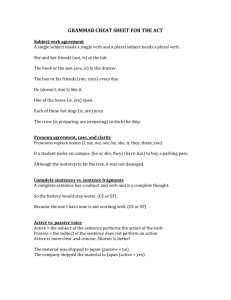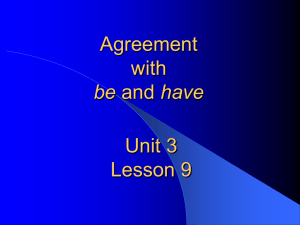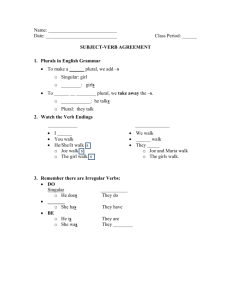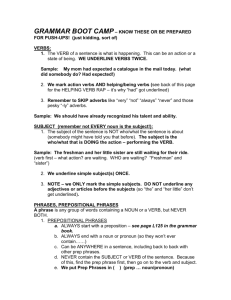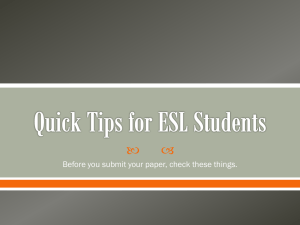Grammar Jigsaw Answer Key
advertisement
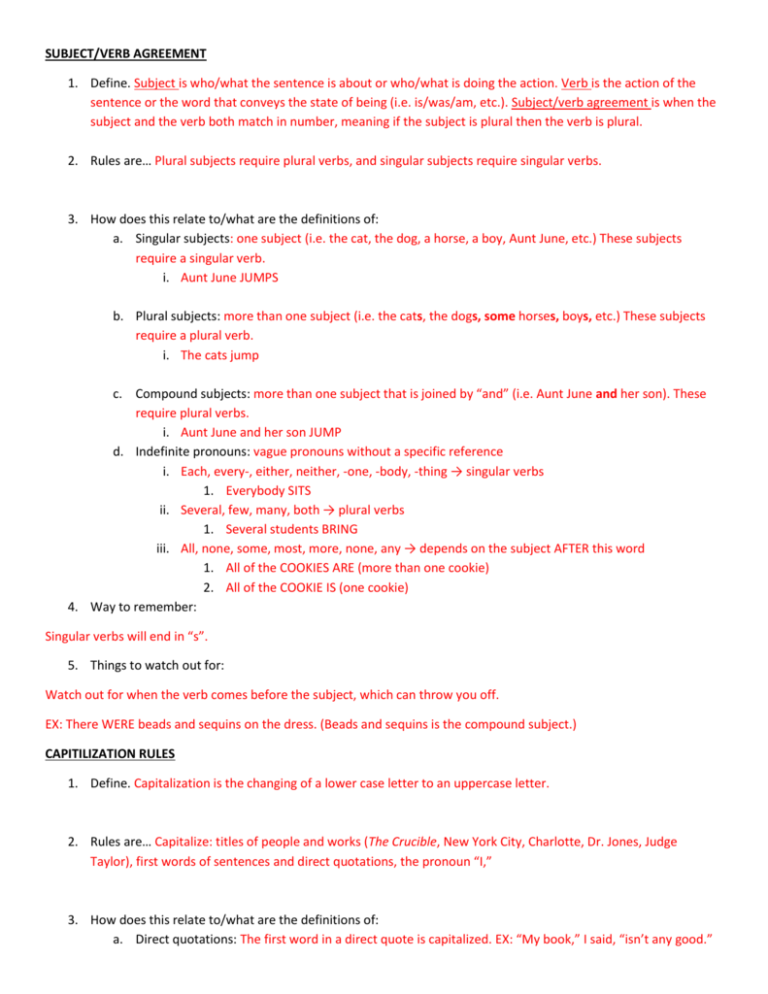
SUBJECT/VERB AGREEMENT 1. Define. Subject is who/what the sentence is about or who/what is doing the action. Verb is the action of the sentence or the word that conveys the state of being (i.e. is/was/am, etc.). Subject/verb agreement is when the subject and the verb both match in number, meaning if the subject is plural then the verb is plural. 2. Rules are… Plural subjects require plural verbs, and singular subjects require singular verbs. 3. How does this relate to/what are the definitions of: a. Singular subjects: one subject (i.e. the cat, the dog, a horse, a boy, Aunt June, etc.) These subjects require a singular verb. i. Aunt June JUMPS b. Plural subjects: more than one subject (i.e. the cats, the dogs, some horses, boys, etc.) These subjects require a plural verb. i. The cats jump c. Compound subjects: more than one subject that is joined by “and” (i.e. Aunt June and her son). These require plural verbs. i. Aunt June and her son JUMP d. Indefinite pronouns: vague pronouns without a specific reference i. Each, every-, either, neither, -one, -body, -thing → singular verbs 1. Everybody SITS ii. Several, few, many, both → plural verbs 1. Several students BRING iii. All, none, some, most, more, none, any → depends on the subject AFTER this word 1. All of the COOKIES ARE (more than one cookie) 2. All of the COOKIE IS (one cookie) 4. Way to remember: Singular verbs will end in “s”. 5. Things to watch out for: Watch out for when the verb comes before the subject, which can throw you off. EX: There WERE beads and sequins on the dress. (Beads and sequins is the compound subject.) CAPITILIZATION RULES 1. Define. Capitalization is the changing of a lower case letter to an uppercase letter. 2. Rules are… Capitalize: titles of people and works (The Crucible, New York City, Charlotte, Dr. Jones, Judge Taylor), first words of sentences and direct quotations, the pronoun “I,” 3. How does this relate to/what are the definitions of: a. Direct quotations: The first word in a direct quote is capitalized. EX: “My book,” I said, “isn’t any good.” b. Proper nouns: Proper nouns are capitalized. EX: Aunt Mabel, New York City c. Titles: Titles of people and titles of works , like movies and books, are capitalized. i. EX: Dr. Jones, Mrs. Loukos, The Crucible, d. Pronouns: “I” is capitalized. e. First words in a variety of uses: The first word in a sentence and direct quote is capitalized. 4. Way to remember: 5. Things to watch out for: If you are referring to someone with a title of some sort, both the title and his/her name are capitalized. a. Mrs. Loukos, NOT mrs. Loukos or Mrs. loukos PARALLEL STRUCTURE 1. Define. Parallel structure refers to making parts of a sentence align in grammatical form. For example, “I like sweet potatoes, red peppers, and country ham.” The grammatical pattern of that list is adjective (sweet) + noun (potatoes). 2. Rules are… If phrases or words are repeated in a sentence, they must all be set up in the same form. 3. How does this relate to/what are the definitions of: a. Lists: All the components of a list must be set up in the same way (see example in the definition) b. Conjunctions: Phrases that follow conjunctions (especially correlative conjunctions) must follow the same form. i. EXAMPLE: Neither the really long book nor the really short book is good. Neither/nor = correlative conjunctions Pattern after each: article (the) + adverb (really) + adjective (long) + noun (book) c. Verbs: Verb tense must be consistent; if you used past tense, it must ALL be past tense. If you use present tense, it must be ALL present tense. d. Phrases: Multiple phrases must have the same construction. i. EXAMPLE: I went through the house, out the door, and across the yard. ii. PATTERN OF PREPOSITIONAL PHRASES: preposition (through) + article (the) + noun (house) 4. Way to remember: Think about parallel lines and how they are the exact same, never crossing to create a change. 5. Things to watch out for: USING MODIFIERS CORRECTLY 1. Define. Modifiers are any words that change or specify another word. 2. Rules are… Modifiers must be placed in a location in the sentence that will make it clear what is being modified and how. Typically, this means it will be located near the word it is modifying. 3. How does this relate to/what are the definitions of: a. Adjectives: Adjective modify/describe nouns and pronouns. b. Adverbs: Adverbs modify/describe verbs, adjectives, and other adverbs. c. Location in a sentence: Modifiers – whether phrases or one word – must be close to what they are modifying. d. Limiting Modifiers: Limiting Modifiers place restrictions on what it’s modifying. These are word like none, most, only, etc. e. Dangling Modifiers: Dangling Modifiers are modifiers which are not clear in what they are modifying. Typically, these will be phrases. This is a grammatical ERROR. i. EXAMPLE: Drinking all of the water, the team had nothing to drink when they finished the game. ii. In this example, the first phrase is the modifying phrase. It is MEANT to refer to a player who drank all the water, but it sounds like the TEAM drank all the water, though really they are the ones who didn’t get any water. 4. Way to remember: MODIFY = change 5. Things to watch out for: RUN-ON SENTENCES 1. Define. Run-on sentences are made up of more than one independent clauses that incorrectly joined. 2. Rules are… Independent clauses must be joined with semicolons, colons, commas and conjunctions, or separated into two sentences. 3. How does this relate to/what are the definitions of: a. Semicolons: Semicolons (;) join two I.C.’s (independent clauses) that are CLOSELY RELATED IN CONTENT. b. Commas: Commas can correct run-on sentences IF they go in front of a coordinating conjunction (FANBOYS). c. FANBOYS (Conjunctions): FANBOYS can join I.C.’s if accompanied by a comma in front. i. EXAMPLE: I ate the cupcake, and Maria ate the cookie. d. Fused sentence: Fused sentences are two or more I.C.s that are joined without any punctuation. This is an ERROR. e. Comma splice: Comma splices are two or more I.C.s joined with ONLY a comma. This is an ERROR. f. Colon: Colons prevent run-ons by separating an I.C. from an adjoining list or clarifying a definition. i. EXAMPLE: He told me the following she refuses to go with you. ii. CORRECT: He told me the following: she refuses to go with you. 4. Way to remember: 5. Things to watch out for: Always check your clauses! If you have more than one I.C., it must be joined correctly!


